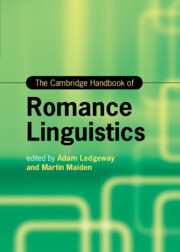Book contents
- The Cambridge Handbook of Romance Linguistics
- Cambridge Handbooks in Language and Linguistics
- The Cambridge Handbook of Romance Linguistics
- Copyright page
- Dedication
- Contents
- Figures
- Tables
- Contributors
- Abbreviations
- 1 Data, Theory, and Explanation: The View from Romance
- Part One What Is a Language?
- Part Two Phonetics and Phonology
- Part Three Morphology
- Part Four Syntax
- 16 Argument Structure and Argument Realization
- 17 Agreement
- 18 Alignment
- 19 Complex Predicates
- 20 Dependency, Licensing, and the Nature of Grammatical Relations
- 21 Parametric Variation
- Part Five Semantics and Pragmatics
- Part Six Language, Society, and the Individual
- Index
- References
21 - Parametric Variation
from Part Four - Syntax
Published online by Cambridge University Press: 23 June 2022
- The Cambridge Handbook of Romance Linguistics
- Cambridge Handbooks in Language and Linguistics
- The Cambridge Handbook of Romance Linguistics
- Copyright page
- Dedication
- Contents
- Figures
- Tables
- Contributors
- Abbreviations
- 1 Data, Theory, and Explanation: The View from Romance
- Part One What Is a Language?
- Part Two Phonetics and Phonology
- Part Three Morphology
- Part Four Syntax
- 16 Argument Structure and Argument Realization
- 17 Agreement
- 18 Alignment
- 19 Complex Predicates
- 20 Dependency, Licensing, and the Nature of Grammatical Relations
- 21 Parametric Variation
- Part Five Semantics and Pragmatics
- Part Six Language, Society, and the Individual
- Index
- References
Summary
Research into comparative syntax over the last four decades has revealed that, despite some quite considerable superficial differences, syntactic variation among different languages and varieties is not random, but is ultimately constrained by a small and finite set of principles and parameters, the number and nature of which can be successfully teased apart especially through the careful study of closely related languages and varieties where, all other things being equal, a particular parametric choice can be readily isolated. It is for this reason that investigations of parametric variation in the area of syntax have so often drawn on Romance data since empirical investigations of Romance morphosyntax, especially of non-standard varieties and dialects in more recent times, have uncovered a wealth of small-scale microvariation. Drawing on such examples as the variation found in subject clitic systems, auxiliary selection (variously driven by transitivity, mood, tense, and grammatical person), active participle agreement, the extent and distribution of verb movement, sentential negation, and C(omplementizer)-systems (e.g., dual/triple complementizer systems; V2; availability of V-to-C movement and focus fronting), this chapter provides a critical overview of the some of the principal dimensions of morphosyntactic parametric variation with the aim of identifying the nature of the choices involved and, in particular, the differences between macro-, meso-, micro-, and nanoparameters and how these are formally organized within the grammar, the interaction between these parameters both in diachrony and synchrony, and what the formal limits of such parametric variation are.
Keywords
- Type
- Chapter
- Information
- The Cambridge Handbook of Romance Linguistics , pp. 637 - 670Publisher: Cambridge University PressPrint publication year: 2022
References
- 1
- Cited by



